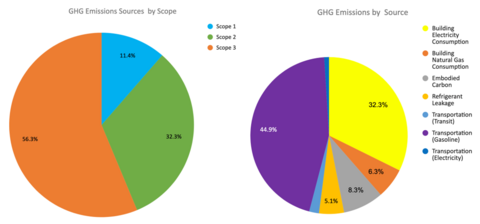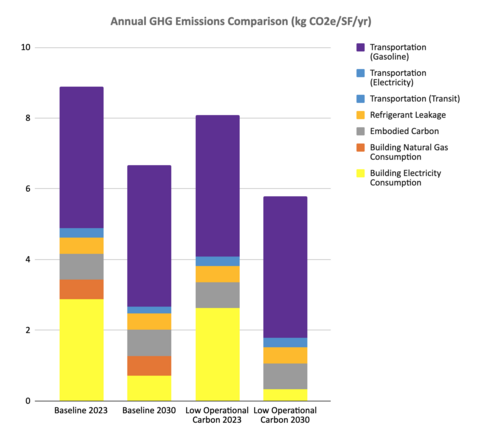Josh. . . I like your approach here but, as with most analyses, the assumptions are key. Assume commutting 3x per week due to a hybrid work scheudle and that tranportation bar shrinks by 40%. Assume in the 2030 analysis that there are a lot more electric cars (and a cleaner grid) and it will change the transportation portion as well. Assume 30-year building (or 100-year building) and the emboddied carbon portion shifts quite a bit. All of these could be reasonable assumptions. This kind of analysis really needs error bars and/or high/low scenarios. . . dare I say some sort of web-based widget where design teams could bracket different assumptions and see how these impact overall predicted lifecycle CO2 emissions. . .
Op-Ed
This is the Universal Low-Carbon Building Standard We Need
This is the second article in a five-part series introducing a comprehensive, universal carbon standard for buildings. Part One explains how “net zero” has failed us. Part Two (this one) introduces the six building blocks of a proposed low-carbon standard. And Part Three provides details on each of those six things.
Part Four explains why we need to prohibit offsets and RECs, and eliminate other distractions, and Part Five offers a condensed recap as well as a path toward adoption of this comprehensive low-carbon standard across the building sector.
The greenhouse gas (GHG) emissions from buildings fall into five categories.
- Operational energy: gas or diesel consumption (scope 1)
- Operational energy: electricity consumption and purchased heat or chilled water (scope 2)
- Refrigerant leakage (scope 1)
- Embodied emissions (scope 3)
- Transportation emissions (scope 3)
This is dramatically simpler than a corporate GHG inventory, for which there are 15 categories of scope 3 emissions in addition to those in scopes 1 and 2.
When a building becomes operational, many activities associated with that building’s purpose typically fall into one or more of these 15 scope 3 categories that corporations report.
So the list above is really just the emissions associated with constructing and operating the building itself, not with its subsequent business operations or manufacturing products. So the Universal Low-Carbon Building Standard I’m proposing would eventually become a subset of an organization’s larger GHG footprint. But those involved with a new construction project, major renovation, or ongoing operations of a building or portfolio wouldn’t make any claims about net zero, but instead would claim (and demonstrate) compliance with a comprehensive standard that addresses all of these sources of emissions.
Why we need a comprehensive standard
There are multiple net-zero building certification programs—two from the International Living Future Institute (ILFI), two from USGBC, and one from Passive House—but none of these address all five emissions sources.
ILFI omits refrigerants and transportation in its Zero Carbon program, and while it requires a 10% reduction in embodied carbon, it requires offsets for the balance to reach zero.
LEED Zero, on the other hand, omits embodied carbon and electrification, and in addressing transportation, it accepts purchased offsets to compensate for emissions from commuting.
What’s more, both organizations offer choices about whether to pursue zero energy or zero carbon and have different compliance pathways for each, meaning you can choose to include embodied carbon or not, or choose to include transportation or not.
To illustrate the importance of including all five emission sources, the following is a breakdown of the annual GHG emissions per square foot (SF) for a semi-urban office building by source and by scope, referencing U.S. average grid emissions factors.[1]

- This is a mid-size office building with an energy use intensity (EUI) of 35, based on the IECC 2021 International Energy Conservation Code.
- It has a 70/30 electricity/gas split.
- It provides 500 SF per occupant.
- For transportation, it assumes 2.25 trips per day during work days at 15 miles per trip, where 75% of commuters drive a single-occupancy (SOV) internal-combustion-engine (ICE) vehicle with a fuel efficiency of 30 MPG. The rest take transit, walk or bike, or drive an electric vehicle (EV).
- The embodied carbon assumptions are 398 kg CO2/m2 (referencing the Carbon Leadership Forum benchmark study) amortized over a 50-year period.
- The refrigerant GHG assumptions are 0.45 kg CO2e/SF/yr, based on this City of Seattle analysis.
Let’s say I do all of the component elements of a net-zero-building program, meaning that I improve efficiency, electrify all systems, and add an amount of renewable energy that will fit on the building roof, but I ignore transportation, embodied carbon, and refrigerant emissions and I don’t pretend that there are offsite renewables out there that can actually do anything to reduce my building's emissions.
The following chart illustrates the reductions associated with my “net-zero” building:
- The first bar is my baseline building, described above.
- The second bar is the same baseline building, but in 2030, when U.S. grid intensity will be reduced by another 75%.[2]
- The third bar is the “net-zero-energy” scenario, where I increase efficiency by 20% relative to the baseline (resulting in an EUI of 28), electrify all gas usage with an annual heat-pump COP of 2.5, and meet 20% of the remaining load with onsite solar.
- The fourth bar is the “net-zero-energy” scenario with a 2030 grid.

To be fair, a much larger share of the transportation emissions will shift to the EV camp by 2030, which isn’t included in the analysis yet (I’ll go into that in a future article).
To state the importance of embodied carbon, you often see it compared directly to operational carbon, as in the graph below. In this view, which stacks embodied carbon along with operational energy, the embodied carbon grows to 70% of the total emissions in the “net-zero” scenario in the 2030 grid.
This shows the growing importance of embodied carbon relative to operational carbon, but it also shows that omitting transportation dramatically skews the overall picture.
Introducing the Universal Low-Carbon Building Standard
The proposed framework that I’ve been calling the Universal Low-Carbon Building Standard should do the following.
- Include all sources (scopes 1-3) of building-related emissions for all projects.
- Require teams to quantify the various GHG impacts of different emission sources relative to one another, using global standards to account for scopes 1 to 3.
- Reset the expectations of what getting to zero looks like, including for existing buildings, without confusing the argument by “netting” out real emissions with illusory RECs or other offsets.
- Return the building sector to a sense of simplicity and applicability for any type of project in any geography.
- Have the same pathway for both new and existing buildings, since two-thirds of existing buildings around the globe will still be with us in 2040—not to mention the fact that a “new” building starts “existing” as soon as it’s in operation.
The six elements of the standard
The elements of this new low-carbon standard should be:
- Low transportation emissions, achieved by reducing vehicle miles traveled and promoting the transition to electric vehicles
- All-electric buildings
- Efficient and low-peak-load buildings
- Onsite renewable energy
- Low embodied carbon emissions
- Low or zero refrigerant emissions
These more or less map to the five emission sources, except that for the two categories of operational energy— fossil fuels and electricity—we create three categories: efficiency, renewables, and electrification.
Note that with the exception of building electrification, which is all-or-nothing, all elements are low and not zero. Also, offsite renewables and grid-interactive buildings are conspicuously omitted from this list, which I explain in Part Four of this series.
How the new standard will solve for existing buildings
For existing buildings—either as individual buildings or as portfolios—the universal standard would closely mirror the Science Based Targets initiative approach and principles:[3] building or portfolio owners would quantify a baseline year of emissions, then target reductions of all sources and scopes with a 50% near-term goal (e.g., 2030) and a linear reduction to zero emissions by 2050 (requiring a 75% reduction by 2040).
This would require the building or portfolio owner to deploy the same tactics as new buildings over time, namely: building efficiency and electrification, reduction in vehicle miles traveled, transportation electrification, reductions in refrigerant leakage, and reduced embodied carbon in renovations. As the grid decarbonizes, owners will see reductions without having to take any action, and the transition to electricity from fossil fuels and the uptake of EVs will achieve increasing reductions over time.
Therefore, existing buildings should be seen as works in progress, ideally parts of larger portfolios of buildings that are all decarbonizing on a roughly similar timeline. Because really, who cares if a building owner has one gleaming low emitter among a forest of mediocre performers? Owners need to be focusing on making the biggest reductions possible in as little time as possible across their entire portfolios.
If that portfolio happened to be within a city’s jurisdiction, then a building performance standard would be an excellent way to drive that portfolio-wide reduction in the most efficient manner possible. But the City should also seek to deploy housing projects, density, transit, and EV charging infrastructure, to support the reduction of the full scope of emissions.
Also, this could easily align with reporting mechanisms like GRESB, which could simply adopt the Universal Low-Carbon Building Standard as the foundation for measuring building portfolios’ progress on emissions reductions.
So whether you are implementing a new city energy code, developing a new master plan, designing a new building or data center, or owning and operating any existing building, the same set of principles applies. You address all scopes of emissions and don’t mess around with RECs or offsets.
For new buildings, carbon is reduced immediately or set into progress as the building enters operation. And for existing buildings, the carbon is reduced over time, in line with the SBTi time horizon.
In Part Three of this series, I will unpack the specific requirements for each of the six areas of the Universal Low-Carbon Building Standard.
This series is broken up into the following parts:
- Net Zero Has Failed. We Need a Universal Carbon Standard for Buildings.
- This is the Universal Low-Carbon Building Standard We Need (this one)
- The Universal Low-Carbon Building Standard Does Six Things
- The Universal Low-Carbon Building Standard Avoids RECs and Unnecessary Complications
- The Universal Low-Carbon Building Standard’s Path to Adoption
[2] NREL: Evaluating Impacts of the Inflation Reduction Act and Bipartisan Infrastructure Law on the U.S. Power System. This estimates a grid reduction of 72%–90% by 2030 from a 2005 baseline. I’m assuming 80% since 2005, which, with a 40% reduction already achieved, would be an additional 85% between 2003 and 2030.
[3] Note that the current draft of the building sector guidance for setting science based targets doesn’t provide clear guidance on which sources of emissions to include or how to do the calculations. It leaves much of that to the GHG Protocol, which still allows RECs, a persistent shortcoming. Instead, it says which scope 3 emissions should be claimed by various groups. This is all useful, but I am primarily concerned with the owner of those buildings taking responsibility for all of their emission scopes.
Published August 28, 2023 Permalink Citation
Radoff, J. (2023, August 28). This is the Universal Low-Carbon Building Standard We Need. Retrieved from https://www.buildinggreen.com/op-ed/universal-low-carbon-building-standard-we-need
Comments
Assumptions
Erik -- 100% agree. The point is not that all building will have the same profile, but that regardless of your profile, we should require projects to make reductions in all categories, even if the result is that the impact ends up being proportionally different for different buildings.
Stitching the pieces together
Josh:
Love the clarity of this. All 6 of these things are underway in some form, but all by different groups with different biases and agendas.
1. Low transportation emissions: Federal CAFE standards and automaker commitments to EVs
2. All-electric buildings: cities and states adopting electrification codes, mostly along the urban centers or at the coasts, but the battle and misinformation from gas companies (and the Orwellian named "clean natural" gas)
3. Efficient and low-peak-load buildings: 2030 Committment and local energy codes but most firms (including mine) are way under the 80% we need to be at (though California's Title 24 should get adopted by every state)
4. Onsite renewable energy: often limited by roof and parking lot area, so off-site or PPAs is becoming more of a solution
5. Low embodied carbon emissions: EC3/Tally and others have really helped drive this SO MUCH in the last 5 years
6. Low or zero refrigerant emissions: ASHRAE and PassiveHouse folks have done amazing things with this, but not great at getting this info out to the rest of the industry
Packing this as a new standard makes sense and could galvanize these movements.
The water/carbon nexus is not part of this, but could be.
Looking forward to Parts 3 to 5!







Add new comment
To post a comment, you need to register for a BuildingGreen Basic membership (free) or login to your existing profile.